"In order to regulate the balance of yin and yang, to increase the 'pre-heaven original chi' [hormones] and strengthen the physical body, Da Mo [c. 481 - 539 AD] invented the 'Tendon Changing' and 'Marrow Washing' systems...and taught them to the monks. Later, the essence...was comprehended by the Sung Dynasty general Yue Fei [1103 -1142 AD], and from these systems he created Xing Yi Quan [H'sing Yi Ch'uan] with martial applications...This is the origin of the internal martial arts".
From A Study of Taijiquan by Sun Lu Tang, 1919, translated by Tim Cartnell, 2003.
In 1727, Emperor Yongzheng, fearful of sedition from various sects and cults, suppressed martial arts. This continued until the revolution in 1911. Martial arts were again suppressed, and books and records destroyed, in the Cultural Revolution 1966-1976. Outside the large cities, the government could not enforce the law or protect people. It thus became a matter of life and death to keep martial techniques secret so others could not use them against you. Nearly all history and techniques were passed on verbally only. Most of the population was also illiterate and could not leave written records even of they wanted to. It is therefore difficult to establish definitively the linage of a particular style.
Only after the Boxer Rebellion (1898-1901), when it became clear that modern guns had supplanted martial arts as the most effective way to kill people, did the martial arts community begin to consider that it should be taught openly.
Fu spent 8 years learning pa kwa from Jia Feng Meng, then 3 years in Beijing learning from Yin Fu's top student Ma Gua, and from Cheng Ting Hua at the same time, also a bit from Yin Fu. All were first generation students of Grandmaster Dong Hai Chuan (c1797-1882).
Dong Hai Chuan developed pa kwa from various styles of Shaolin kung fu as well as the daoist circle walking practice. He also possibly borrowed from the principles of tai chi and/or h'sing yi taught in Peking and the countryside, due to pa kwa's striking similarity to these older internal styles. He was chief bodyguard of the Prince of Su in Peking (Beijing).
Sung Wei Yi introduced the sword form to the tai chi system, firstly to Yang Pan Hou, then Li and Fu. From Yang Pan Hou's students it spread to Wu style. Yang Pan Hou's father, Yang Lu Chan (the first person to teach tai chi openly and make it known to the public), did not use a sword to fight, his favourite weapons were the staff and his wooden tobacco pipe.
[Note: this system was called "Wudang" even though it did not come from Wudang mountain. Fu taught Sun Lu Tang the Wudang sword in Nanjing, and in exchange was taught h'sing yi ch'uan].
<------> arrows indicate mutual exchange of knowledge
======== indicates others in between in the linage (not listed by name)
Picture from "Scholar Boxer: Chang Naizhou's Theory of Internal Martial Arts and the Evolution of Taijiquan" by Marnix Wells.
Research by Marnix Wells indicates Jiang Fa may have learnt from Wang Chung Yeuh and then taught this style to Yang Lu Chan's teacher, Chen Chanxing [Chen Chuan Hsing]. Possibly Chen Chung Hsing was also taught 'tai chi' by directly by Wang Tsung Yueh. This could be where internal style principles were first introduced into Chen village fighting methods. In any case, he was subsequently forbidden from teaching Chen style by the village elders.
In 1917, Wu Tu Nan visited Chen village to research, and was directed to Chen Xin, the most literate in the village. Xin confirmed the above and said both internal styles, introduced to the area by Jiang Fa, and external styles, a local variant of Shaolin, were practiced there. Chen introduced Wu Tu Nan to Du Yu Wan who was there at that time practicing internal styles. Du brought out a book in 1935 which also confirmed this linage. [see Peter Lim's research at http://www.itcca.it/peterlim/historg2.htm].
Also to note is the Chen style, pre-20th century, was different than what is now publicly known. Among other things, it was taught with parallel-foot stances to avoid ligament damage in the inner knee. The Illustrated Canon of Chen Family Taijiquan by Chen Xin, translated by Alex Golstein in 2007, describes the old form.
In the 1920s, Chen Fake of Chen village was shown the tai chi classics (of "Chang San Feng" and Wang Tsung Yueh), and said if this is tai chi, then Chen style is not tai chi. Chen style can be seen as a midpoint in the evolution of tai chi out of kung fu, containing the 'spiraling force' elements, but not really emphasising 'overcoming the hard with the soft.'
There is a apocryphal story of how Chang San-Feng invented tai chi after witnessing a fight between a crane and a snake. This is to demonstrate the influence snake and crane styles of kung fu had on the development of tai chi. All styles have actually evolved in a matrix-style fashion, rather than in a lineir progression as shown in diagrams. For example, Yang Lu Chan ("Unsurpassable Yang") taught tai chi to the Imperial Guards in Peking (Beijing) from the 1850s. Dong Hai Chan developed and taught pa kwa in Peking later in the 1800s, and his top student Yin Fu was chosen by the Empress as her personal bodyguard when anarchy forced her to flee. The principles of all three internal styles, tai chi, h'sing yi and pa kwa, are shared so undoubtably there was cross-fertilisation of ideas and practices. This occurs between internal and external styles also.
Prior to Yang Lu Chan learning martial arts in Chen village, and later (mid 1800s) moving to Peking [Beijing], tai chi was unknown publically. It was not even called tai chi until this time. The name was coined after Ong Tong He saw a demonstration in Peking by Yang Lu Chan, and wrote: 'Hands Holding Taiji shakes the whole world,
a chest containing ultimate skill defeats a gathering of heroes.'
The oldest written records of tai chi principles inside the tai chi system are copies of the Tai Chi Classic, attribute to Wang Tsung-Yeuh. The oldest copy is dated 1867 (the "Ma T'ung-Wen edition"), the next oldest (the Li I-Yu copies of the writings attributed to Wu Yu-Hsang and Wang Tsung-Yeuh) dated1880 [see Lost Tai Chi Classics From the Late Ching Dynasty by Douglas Wile].
However, pottery around 7000 years old shows the same techniques (postures and breath control) were known at that time. The standing figure on the jar shown below has their arms in the 'holding the ball' posture common to tai chi training.
The first known detailed written description of chi gung techniques is found on the jade artifact shown below (dated c. 480-200 BCE).
Clip of Taizu fist (ancestor to Chen style)
Clip of other ancestor form (Shaolin longfist)
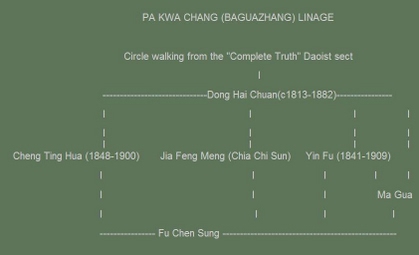
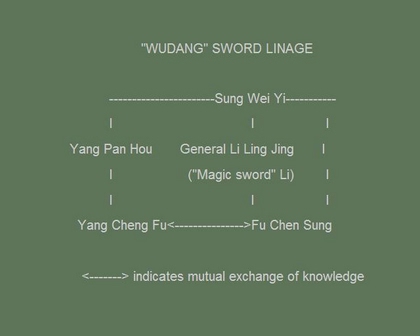
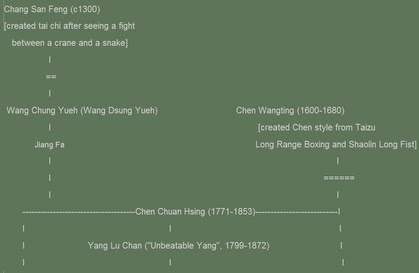

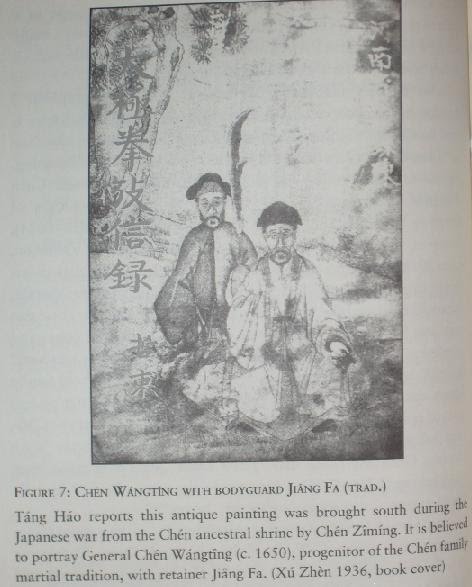
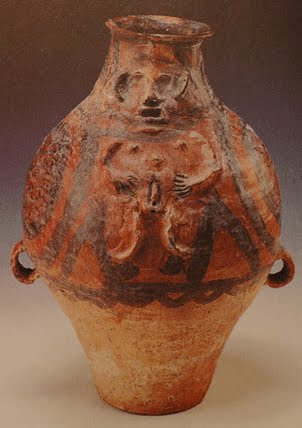

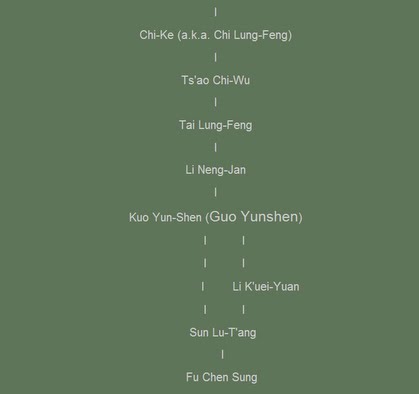
Fu taught Sun Lu Tang the sword in Nanjing, and in exchange was taught h'sing yi ch'uan.
There is written evidence of the linage presented above tracing back to the Chi-Ke (a.k.a. Chi Lung-Feng; a.k.a. Ji Longfeng) who lived c1600-c1680. Furthermore the important principles of h'sing yi, the 'triple allignment' of point of the body, and the 'six co-ordinates' are found in Qi Jiguang's spear manual dated 1562 [see "Scholar Boxer: Chang Naizhou's Theory of Internal Martial Arts and the Evolution of Taijiquan" by Marnix Wells]. H'sing yi verbal tradition claims it was originally developed from spear techniques.